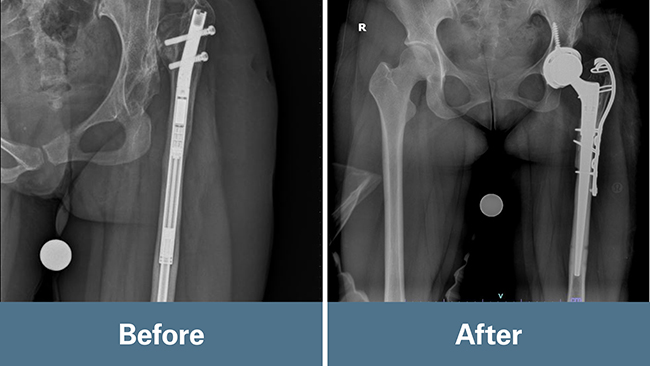A hip replacement at age 24 is not a milestone anyone expects. But for Anh Tran, born with developmental dysplasia of the hip (DDH), the procedure proved inevitable. This extremely rare condition in which the hip joint hasn’t formed normally affects 1% of all newborns. And in 1% of those, the condition is severe enough to dislocate the hip.

“She wanted to be a typical 20-something where she could get around without having pain,” said Steven J. Schroder, MD, an orthopedic surgeon at UT Physicians Orthopedics at Memorial Hermann | Rockets Orthopedic Hospital. “She had muscular pain and range of motion dysfunction, and it was definitely affecting her daily life.”
Learning to adapt as a child
Anh’s family learned of her DDH diagnosis when she was an infant and that her ball-and-socket joint hadn’t properly formed. It limited her childhood and prevented her from participating in sports and activities due to her increased risk of hip dislocation.
Despite bracing, regular physical therapy sessions, and multiple surgeries, Anh’s condition progressed. In her early teens, doctors revealed her condition had advanced too far to be corrected without a hip replacement, which would be required once she finished growing.
Searching for a solution
Through research, Anh realized a hip replacement procedure would enable her to reclaim her life. She described her first consultation with Schroder as incredibly positive. She said he displayed empathy and kindness with a full understanding of her daily pain. The idea of living without pain seemed distant to Anh in early adulthood, as just sitting at work caused excruciating pain.
“Dr. Schroder addressed all of my questions, which were numerous given my thorough research,” Anh said. “He couldn’t guarantee complete relief from pain due to the complexity of my case, but he assured me he would give his utmost effort.”
Planning the hip replacement procedure
Anh was not the typical dysplasia patient, according to Schroder, an assistant professor of orthopedic surgery at McGovern Medical School at UTHealth Houston. Her case required reverse engineering and an outside-the-box surgery. This procedure is unlike anything Schroder has seen in his practice, fellowship, or medical meetings.
“It’s atypical based on the original orthopedist years ago putting a revolutionary growing nail (metal rod) into her femur, with the idea it would provide some benefit in the short run,” Schroder said.
At age 15, Anh underwent a nine-hour leg lengthening surgery as a temporary measure until she stopped growing and a hip replacement could be done. At the time, lengthening her femur bone was a first-of-its-kind procedure at the hospital where it was performed.
“A lot of engineering and math went into our surgery because we had to determine Anh’s actual leg length discrepancy and how much bone we needed to subtract from her femur to match the femur length on the other side,” Schroder said. “It ended up being about 4 centimeters.”

The concern was lengthening too much, and it could stretch the sciatic nerve. This translates to a leg with nerve palsy that could create muscle weakness, elasticity, and sensation problems.
Another concern was the muscles around the hip girdle, which had never been used in the usual way. As a result, they were scarred, shortened, and weak.
“The challenge was to bring the hip down to its normal position,” Schroder said. “But we didn’t know if she would have significant control of these muscles and how they would respond.”
Achieving a surgical success
Schroder said the surgery would entail a long day with unknowns and thinking on the fly. Thankfully, it went as planned for her and the surgical team. They did a large release of the capsular tissue from the top of the hip, removed the femur rod, and subtracted the prescribed amount of bone. They placed the implant in the bone and the shaft of the bone to build the replacement back up to the normal femur length.
“I knew we would be able to put her in a better situation after surgery by taking away her arthritic pain and the pain she was having from the previous surgery and dysplasia,” Schroder said. “The real question concerned her functionality because it hadn’t been used as a normal limb.”
Living with a new hip
The change was immediate. After surgery, Anh’s legs initially felt heavy and sore, but the pain she had grown accustomed to was gone. For the first time, Anh didn’t have to wince through every movement or calculate whether her daily activities were worth the discomfort.
“Now, I can aimlessly wander or handle daily tasks without thinking twice — or bracing myself for the pain,” Anh said. “Simple things, like going to the grocery store or climbing a flight of stairs, no longer feel like a struggle or something I think twice about. They just come naturally now.”
Schroder said he held Anh back the first couple of weeks to allow things to settle and ensure she had proper stability. Then, she knocked it out of the park in therapy. Through dedicated physical therapy and personal determination, Anh returned to the gym six months after surgery. She even achieved personal milestones like a 380-lb. leg press.
“Unlike before, where weightlifting was a means to manage pain, I now experience consistent progress and strength gains, a feeling that’s truly liberating,” Anh said. “I feel like a new person, full of optimism for the future. The journey has been transformative, allowing me to take control of my health and life.”
New lease on life

Today, Anh’s life is dramatically different. She has traveled extensively, often walking 10,000 to 30,000 steps daily during her adventures. Japan, Switzerland, Italy, South Korea, and Canada provided a beautiful backdrop to explore. She can now confidently pursue an active lifestyle, which includes cycling, weightlifting, and long walks with her dog, Bumi.
“The surgery was a pivotal moment, allowing me to overcome challenges and focus on getting stronger each day,” Anh said. “Dr. Schroder believes this is just the beginning of my journey and said we’ll be friends for life. I need to return every five years or so for checkups!”
Uncertainty of future surgery
As a younger patient with a high level of activity, Schroder acknowledges there is some uncertainty about how long the hip replacement will last. He tells hip replacement patients the metal is not going to wear out, so it should last Anh a lifetime.
“Historically, the plastic side of the implant on the cup is the weak link and determines the longevity of an implant,” Schroder said. “Current in vivo data (real-time conditions with a living organism) shows 20-25 years without significant wear, so there may be a need for another surgery. It would be a much smaller surgery and much further down the road. My hope is we don’t have to do anything.”
Focusing on the goal
Schroder describes Anh as a needle in a haystack when it comes to patients. She outperformed expectations, was always reliable, met responsibilities, and asked for more therapy to ensure she achieved her goals.
“She’s definitely had her eye on the ball and pushed through many challenges,” Schroder said. “It’s hard to believe that she’s getting even better after two years. That’s a tribute to her dedication and drive to get as normal as she can on that side.”


